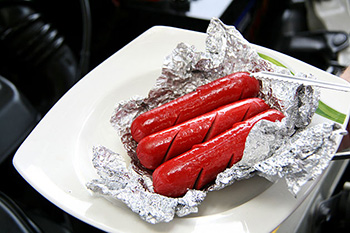Winter storms can strike at any time, leaving you stranded and in need of food. Learn how to use your car’s engine to cook meals that will keep you warm, safe, and fed during an emergency.
Steps for Cooking on Your Car Engine
If you're stranded in a snowstorm, your car can be a lifesaver for both warmth and food. Follow these simple steps to cook your meals on your car engine:
- Spread multiple sheets of heavy-duty tin foil on top of each other to create a multi-layered sheet. This will ensure that no juices or food escape during heating. It’s better to have too much tin foil than too little.
- Optionally, spray the tin foil with butter or a non-stick spray to prevent sticking. (This step is useful, but not essential in emergencies.) Read about 10 Awesome Uses for Tin Foil
- Place a single serving of your meal in the center of the tin foil. Add meat, vegetables, and seasonings of your choice.

- Avoid overly juicy dishes, as juices may escape and damage your engine.
- Fold the tin foil around the meal. Start by folding the right side to the middle, then the left side, and finally fold the top and bottom over the food, creating a tight seal.
- Press down on the tin foil to compact it and make the package as small as possible.
- Turn off the engine and open the car hood.
- After the car has been running for a few minutes, hover your hand over various parts of the engine to find the hottest areas. Use the hottest parts for thick meats and the cooler areas for vegetables or fish. If driving, ensure the food is in a cooler spot to avoid burning.
- Form a simple cone out of extra tin foil and place it in the section of the engine where you want to cook the food. Close the hood and check if the hood presses down on the cone. If it does, that’s your gauge for how tall the meal can be.
- If you plan on driving with the food cooking, secure it in place using wiring to prevent it from moving.
Note: When choosing a location on your car engine, avoid blocking airflow or moving parts like the accelerator linkage. Messing with these components can prevent your car from starting or stopping properly.
Cooking Time & Distance
Cooking times vary depending on the dish and your driving distance. Here are some guidelines:
- Shrimp – 35 miles, about 30 minutes
- Salmon – 40 miles, 45-55 minutes
- Boneless Chicken – 60 miles, 1 hour
- Pork Tenderloin – 200-300 miles, 4-6 hours
If you're driving at an average speed of 65 mph, plan your distance accordingly to ensure the food is properly cooked.
Removing the Meal
- Turn off the engine and open the hood.
- Carefully remove the tin foil package using tongs or a tool to avoid burning yourself.
- Open the tin foil package carefully and enjoy your meal!
Car Engine Recipes
These recipes are from Manifold Destiny: The One! The Only! Guide to Cooking on Your Car Engine! While they may not be suitable for an emergency (due to limited ingredients), they can help you practice this cooking technique.
Good & Simple Cajun Shrimp/Crayfish
Cooking distance: 35 miles
Ingredients:
- 1 pound large shrimp or crayfish tails, in shells
- 6 small green hot peppers
- 2 cloves garlic
- 1 medium onion, finely chopped
- Butter or spread
- Salt & pepper
Remove seeds from peppers and mince them with the onion and garlic. Butter your foil, add the shrimp, and cover with the spicy mixture. Sprinkle with salt and pepper, then triple-wrap the foil. Place it on a medium-hot part of the engine and enjoy delicious shrimp or crayfish!
Any-City Chicken Wings (Sweet)
Cooking distance: 140-200 miles
Ingredients:
- 18 chicken wings
- 1/2 cup ketchup
- 1 cup red wine vinegar
- 1-2 tsp red pepper flakes
- 4-6 minced jalapenos
- 3 cloves garlic
- 1 tbsp oregano
- Pinch of salt
Blend the ingredients (except wings) and pour over chicken wings. Refrigerate for at least 24 hours, then wrap the wings in foil. Brush with marinade and triple-wrap the foil. Place the package on the engine, cook for about 200 miles or 3.5 hours, and enjoy crispy chicken wings.










